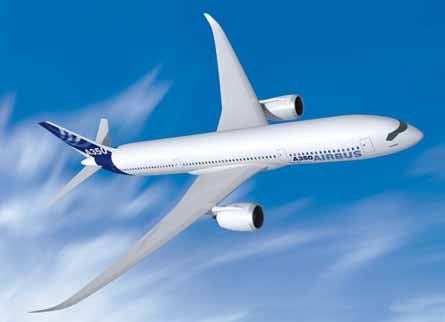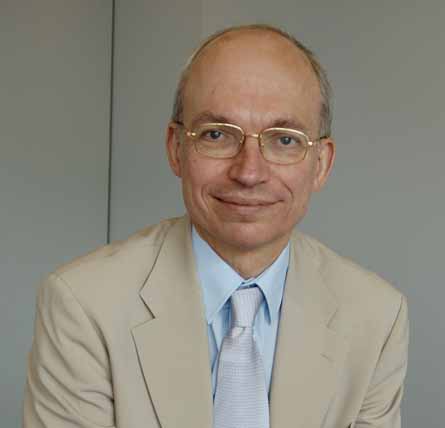Airbus is taking a "clean sheet" approach to the production and development plan for the A350, just as it has done with the design. It has abandoned its traditional development schedule as it seeks to reduce the time spent creating new aircraft and is selecting key suppliers of systems and aerostructures much earlier than previously. This is in part to accelerate the aircraft's development cycle to minimise the lag behind the rival Boeing 787, and also as a result of the A380 production catastrophe and the ensuing Power8 cost-saving plan.
|
|---|
The A350 production plan calls for greater reliance on external suppliers |
The A350 development programme is in full swing as Airbus works towards its target of beginning deliveries of the lead variant - the -900 - in mid-2013. For this to happen, final assembly needs to start in the second quarter of 2011 to allow a first flight in the first quarter of 2012.
But Airbus is currently still more than a year away from the "freeze of aircraft concept" - which it dubs "maturity gate (MG) 5". It is due to reach the "MG4.1" point by the end of June, when it will freeze the aircraft's performance, undertake a major design review and decide on trade-offs in the aircraft's configuration, before moving into the detailed definition phase. Between MG4.1 and the freeze of the aircraft's general concept and characteristics (MG4.2, due in the first quarter of 2008), Airbus will complete the selection of aerostructures risk-share partners and major systems suppliers.
"We will be in the concept phase until quarter four of 2008. This is an important phase where we will lay the foundations for a smooth industrialisation and the start of production at the beginning of 2009," says A350 programme manager Didier Evrard.
For the A350, Airbus is undertaking a far more integrated development effort with suppliers and partners, which is driving the effort to make selections early.
"This summer will see the first big step in the selection of suppliers for components that are time-critical," says Evrard. He adds that the selections are being made a year earlier in the development cycle than previous programmes "because we want to involve them earlier and work jointly with them. This is a new approach that will give us a sustainable competitive advantage."
|
|---|
Evrard: "Lessons from the past" |
Claude Henri Hereus, vice-president suppliers risks and councils, says that the joint development of systems will enable the design effort "to be transferred from Airbus engineers to the system suppliers' engineering teams".
A key element of the Power8 restructuring is the reorganisation of Airbus's supplier base, which will be achieved by moving many existing tier-one suppliers to tier-two status. "More and larger responsibilities will be given to fewer suppliers," says Hereus, enabling the number of work packages to be significantly driven down. "Our target is to reduce aircraft systems work packages from around 150 on the A330/A340 to fewer than 90, and cabin systems from 100 to fewer than 20."
Similarly, production is set for a shake-up as the A350 will be the blueprint for future Airbus programmes where greater reliance will be put on external partners. Half of the A350's aerostructures work will be seconded to risk-sharing partners, compared with less than 30% on previous programmes.
Airbus has already reached agreements for the outsourcing of 8% of the airframe work - 5% to China and 3% to Russia. Evrard says that "most of the partners will be selected during the summer".
Meanwhile, the thorny issue of how A350 production will be allocated within the Airbus plant network across Europe has also been finalised, says Evrard.
"The industrial philosophy, which was a headache at the launch of the programme, is now an asset because we know exactly where things are going to be done in Airbus," he says.
A350 final assembly will be undertaken in Toulouse which "will enable us to make use of the existing facilities", says Evrard. He adds that major component assembly will be the responsibility of Airbus's "five integration sites - Broughton [UK], Getafe [Spain]), Hamburg [Germany], Stade [Germany] and St Nazaire [France]".
The final piece of the A350's new development jigsaw is the programme management philosophy itself. "Because of the problems we had on the A380, I was asked to carefully take the lessons of the past," says Evrard.
The programme management is being run by a central plateau team, "which is bringing together the best of Airbus's engineering know-how, wherever it is working, under a single leader - chief engineer Gordon McConnell", says Evrard. The team is based in two buildings by Blagnac airport in Toulouse near Airbus's existing headquarters. "We plan to have 600-700 people from Airbus, suppliers and risk-sharing partners in the central plateau during the concept phase," says Evrard.
As the programme progresses, an increasing amount of work will be allocated to local plateaus located "where the core competencies lie in our centres of excellence", but they will remain under the control the Toulouse-based central plateau. Internal and external contributors to the programme will also become increasingly involved, with this involvement growing significantly once the concept freeze (MG5) is reached late next year, and the production effort begins.
"From day one, the people in charge of delivering the major aircraft components sit around my programme table as well as being part of the centre of excellence teams," says Evrard. "This will ensure a seamless transition from concept to production."
Related links:
Playing catch up - No margin for error with the A350
Flight's commercial aircraft directory
For more news, pictures and information about the Boeing 787 Dreamliner, please visit our 787 Aircraft Profile page
Source: Flight International





















